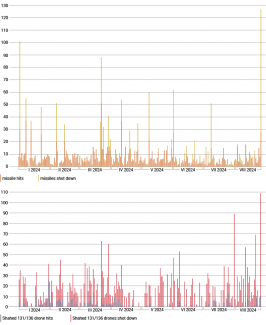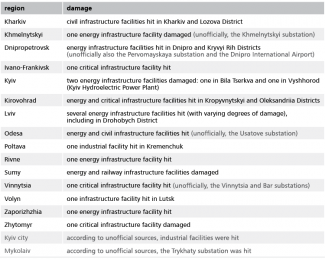Large-scale Russian strike on Ukraine’s energy infrastructure
On 26 August, Russia carried out another large-scale attack on Ukraine’s infrastructure, primarily targeting the energy grid, using a record number of weapons (see chart). According to the Ukrainian Air Force Command, a total of 127 missiles of various types and 109 strike drones were involved in the attack, with 102 missiles and 99 drones reportedly being shot down. According to local sources though, fewer missiles were used and air defence was less effective. Prime Minister Denys Shmyhal confirmed that damage had been reported in fifteen regions of Ukraine (see table), and the electricity grid operator Ukrenergo has decided to implement emergency power outages across the country. In Kyiv and several regional capitals, water supplies have also been disrupted. Railway traffic has been partially halted, and to maintain long-distance connections, the railway company Ukrzaliznytsia has deployed diesel-powered trains. On 27 August, possible power outage alerts were announced in some regions (including in Kyiv city and the Kyiv Region). The power outages could last over 12 hours per day.
The Russians primarily struck power substations. By early afternoon though, it was confirmed that enemy missiles had also hit the Kyiv Hydroelectric Power Plant in Vyshhorod (located north of the capital, with an installed capacity of 440 MW). According to government officials, however, no significant damage occurred. Ukraine’s State Emergency Service reported that seven people were killed and 47 injured.
Commentary
- The strike on energy infrastructure is part of a series of attacks (see ‘Ukraine: the energy infrastructure crisis and the potential for a new wave of refugees’) that began in March this year. Unlike previous attacks, the main targets were most likely not power generation facilities but rather elements of the transmission network. The strike occurred during a period of relative stability in the power system. In the second half of August, with few exceptions, no power outages were planned, due to lower consumption and the completion of maintenance work on nuclear power plant units. Ukrenergo had even announced the resumption of energy surplus exports to the EU. These plans have been suspended following the recent attacks, though. Unless Russia strikes again, stable power supplies should be restored within a few days or up to two weeks. Regular power outages are expected to start across the country in late October anyway because power generation facilities had been damaged from March to June.
- The prevailing narrative among Ukrainian commentators is that the attack is a Russian act of revenge for the incursion of the Ukrainian Armed Forces into Russian territory. Observers had expected this kind of attack on Independence Day, 24 August. Until now, Russia had not targeted hydroelectric power plants in northern Ukraine. Given the situation following the destruction of the dam at the Kakhovka Hydroelectric Power Plant (see ‘The dam on the Dnieper at Nova Khakovka has been blown up. Day 467 of the war’), the strike on the Vyshhorod Hydroelectric Power Plant can also be interpreted as a threat to cause a technological catastrophe which could endanger the Ukrainian capital (a large part of Kyiv and its surrounding areas would be flooded).
- It took a perceptibly long time for the Ukrainian military authorities to inform the public about the aftermath of the attack. The statement from the Air Force Command was released at least six hours later than usual. This gives an idea of the scale of the strike and the associated difficulties in gathering data about the attack. The relatively low number of fatalities and injuries suggests that the actual effectiveness of Ukrainian air defence was closer to the estimates provided by local sources, as the victims were mostly people injured by falling debris. Direct – whether intentional or accidental – hits on strictly civilian facilities are rare (the number of casualties from a single building in such cases is often significantly higher than in the entire territory of Ukraine following the 26 August attack). The redeployment of some air defence systems, which had been protecting targets deep within Ukraine, to cover the Ukrainian forces in the Kursk region, may have also led to the Russian strikes being more effective.
Chart. Missile and drone attacks in 2024

Source: OSW's own estimates based on information from the General Staff of the Armed Forces of Ukraine, the Air Force Command of the Armed Forces of Ukraine, and regional military administrations.
Table. Damage caused by the attack according to local sources






